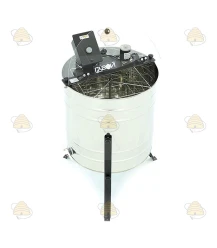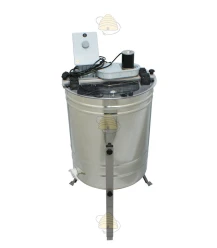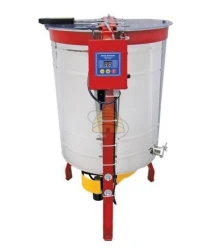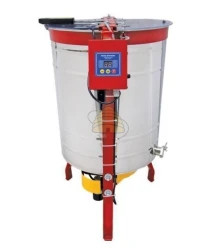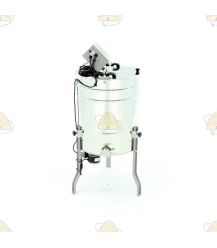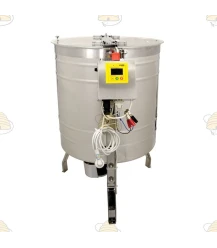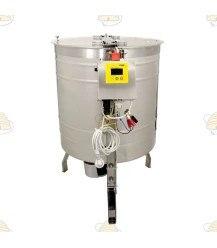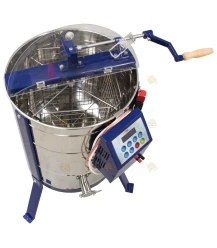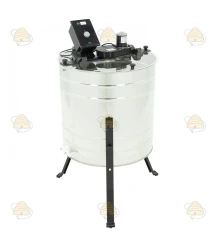Electric tangential honey extractors
Buying an electric honey extractor is an important step for a beekeeper. It increases efficiency in your apiary. While the electric honey extractor is running, you can keep uncapping the honey super frames or brood box frames you’re extracting. With a honey extractor, it’s important to consider your needs. As a rule with a honey extractor – and that’s tip one – price reflects quality. We offer various extractors where you can expect the price to depend on size, finish, robustness, and sometimes motor power. If you only have a few hives and want to extract a few times per year, yet still want an electric honey extractor, a small budget will often do. But if children are watching during extraction and you want more safety, you’ll often move into a higher price bracket.
-
Honey extractor protective cover - BeeFun®
€ 35,95 In stock and available for immediate delivery.Protective cover for a honey extractor with a maximum diameter of 520 mm. The cover is teardrop-shaped so the crank handle also fits underneath. With this cover you keep the extractor clean for the next extraction run!View more -
500 mm 4-frame electric honey extractor
€ 826,95 In stock and available for immediate delivery.Basic honey extractor for extracting 4 brood box frames or 8 honey super frames at a time. This extractor is an ideal entry-level model for the beekeeper who wants electric extraction without spending too much. The difference from the more premium models lies in the motor power and the thickness of the stainless steel (inox) material. Note: this...View more -
600 mm 4-frame electric honey extractor (Deluxe)
€ 1.341,95 In stock and available for immediate delivery.Four-frame electric honey extractor. This extractor features a stainless steel drum with a sloped bottom and metal gears. The drum diameter is 60 cm. The frame basket is also made of stainless steel. The 250 W motor can spin fast or slow as desired, with a maximum rotational speed of 480 rpm. The frame basket is universal and compatible with simplex,...View more -
600 mm 4-frame electric honey extractor (Basic)
€ 858,95 € 908,95 In stock and available for immediate delivery.Basic electric honey extractor 600 mm for extracting 4 brood box frames at a time or 8 honey super frames. This honey extractor is an ideal entry-level model for the beekeeper who wants electric extraction without spending too much. The difference compared to higher-end models is the motor power and the thickness of the stainless steel (INOX). Note: this...View more -
500 mm 3-frame electric honey extractor (Deluxe)
€ 1.238,95 In stock and available for immediate delivery.This three-frame electric honey extractor has a stainless steel drum with a conical bottom. The drum is 50 cm wide. The frame basket is also made of stainless steel. Metal gears. The 250W motor can run fast or slow as desired, with a maximum rotation speed of 480 rpm. The frame basket is universal and suitable for including Simplex, Dadant, etc. 5-year...View more -
500 mm 4-frame electric honey extractor (Deluxe)
€ 1.269,95 In stock and available for immediate delivery.This 4-frame electric honey extractor has a stainless steel drum with a conical bottom. The drum diameter is 50 cm. Both the drum and the frame basket are made of stainless steel. The 250 W motor can run fast or slow as desired, with a maximum speed of 480 rpm. It offers 10 speed settings. The frame basket is universal and suitable for simplex, Dadant,...View more -
500 mm 3-frame electric honey extractor (Easy)
€ 1.104,95 This product is ordered, delivery time is approximately 2 to 6 weeks.Easy three-frame electric honey extractor for extracting 3 brood box frames at a time or 6 honey super frames. This extractor features a bottom-mounted drive beneath the extractor drum and has the electronics on the extractor in a powder-coated housing. A robust extractor for the beekeeper who wants electric extraction at a reasonable price. The...View more -
600 mm 4-frame electric honey extractor (Premium)
€ 2.142,95 This product is ordered, delivery time is approximately 2 to 6 weeks.This four-frame tangential premium electric honey extractor has a stainless steel drum with a sloped bottom. The drum diameter is 600 mm. What makes the premium extractor special is that everything is stainless steel and the motor is very powerful at 350 W. The frame basket is universal and suitable for, among others, simplex, Dadant, etc. This extractor...View more -
500 mm 3-frame electric honey extractor (Premium)
€ 1.854,95 This product is ordered, delivery time is approximately 2 to 6 weeks.This three-frame tangential premium electric honey extractor has a stainless steel drum with a sloped bottom. The drum diameter is 500 mm. What sets the premium extractor apart is its all-stainless steel construction and a powerful 350 W motor. The universal frame basket fits simplex, Dadant, etc. This extractor comes with a 7-year warranty! Tip:...View more -
520 mm 4-frame electric honey extractor Deluxe BeeFun®
€ 1.114,95 Out of stockOut of stock520 mm 4-frame electric/manual honey extractor from BeeFun. With this honey extractor you can extract honey either manually or electrically. The extractor features a 250 W motor with a digital display that lets you set spin time, speed, and direction. It also has a memory button to easily recall your previous settings. This honey extractor has a stainless...View more -
520 mm 3-frame electric honey extractor Deluxe BeeFun®
€ 1.063,95 Out of stockOut of stock520 mm 3-frame electric/manual honey extractor by BeeFun. With this honey extractor you can extract honey either manually or electrically. The extractor has a 250 W motor with a digital display that lets you set the extraction time, speed, and spin direction. In addition, the motor has a memory button so you can easily recall your previous settings. This...View more -
600 mm 4-frame electric honey extractor
€ 898,95 This product is ordered, delivery time is approximately 21 days.Electric honey extractor 600mm for extracting 4 brood box frames at a time or 8 honey super frames. This extractor has a basket with fine mesh and no sharp edges. The difference compared to the premium models is the motor power and the thickness of the stainless steel (inox) material. Note: this extractor is delivered as a self-assembly kit. This means...View more
Tips to consider when buying an electric honey extractor
Sturdiness
Key factors for sturdiness include the legs. These may be attached partially to the tank or wrap all the way around it. If they run fully around, the honey extractor is that bit more rigid. There is often also a top band on the drum or tank, which prevents the tank from denting easily. With legs that are only partially mounted, rigidity comes purely from the tank itself, without extra protection.
Motor power
As a rule, every electric honey extractor has a good motor. The motor power is matched to the intended use and extractor type. The manufacturer has engineered this, so you don’t need to worry. But if you’re exacting and want only the best for your apiary, you’ll likely need to invest more to find the perfect honey extractor.
Alternatives
An alternative to an electric honey extractor is, for example, a manual honey extractor or a tabletop extractor. These are cheaper compared to an electric extractor, but they are hand-operated.
Types of electric honey extractors
With an electric honey extractor we usually mean a tangential extractor. In these, the hive frames stand parallel to the outer wall. The honey is flung from the cells by centrifugal forces. It’s important to extract in three stages: first partially on one side, then fully on the other side, and finally the first side again to get the last bit of honey out. This prevents hive frames from breaking due to the force of honey still on one side of the frame.
Other extractor types that are often electric are radial extractors and cassette extractors:
- Radial extractors: All hive frames face the center, so the honey effectively slides out of the cells. You don’t have to flip the frames.
- Cassette extractors: These work similarly to tangential extractors, but the basket flips, extracting both sides of the frames without you having to turn them.
Benefits of an electric honey extractor
An electric honey extractor offers many advantages over a manual extractor. The main benefit is that you no longer have to crank by hand, which is less taxing on your body. It also saves time, because you can perform other tasks while extracting, such as uncapping frames. The process is faster and more efficient, because you can let the extractor run longer without getting tired yourself. This way almost all honey is spun out, even if it takes a while.
Tips for using an electric honey extractor
To get the most from an electric honey extractor, a few key points matter. First, make sure the extractor is level, because an off-level extractor can start moving due to centrifugal forces. It’s also advisable to anchor the extractor firmly to the floor so it doesn’t “walk” during use. To improve this or prevent it, rubber feet are available that protect the floor and absorb some vibration. Balance is essential too: with a three-frame extractor you should always place three hive frames (if needed with an empty frame), and with a four-frame extractor use two or four frames placed opposite each other. It’s also important to protect the floor by placing the extractor on rubber feet or on a clean mat that can be washed at over 60°C. Finally, hygiene is crucial; clean the honey extractor thoroughly after use. This ensures your honey is processed cleanly and safely. This of course also applies to the rest of your honey room.
In summary:
- Level position: Ensure the extractor is level to prevent movement from centrifugal forces.
- Securing: Anchor the extractor firmly to the floor to prevent “walking”.
- Balance: Always load a balanced number of hive frames (for example three or four) for optimal stability.
- Floor protection: Place the extractor on rubber feet or a washable mat.
- Hygiene: Clean the extractor and honey room thoroughly after use.
Do you have any questions? Feel free to contact us. You can always call or email us; we’re ready to provide expert advice. On our website you’ll find a large selection of honey extractors available for immediate online ordering. There’s also a lot of custom work possible. Manufacturers offer various other models that may better fit your specific situation. Let us know, and we’ll be happy to provide excellent, tailor-made advice!
Spare parts for honey extractors
For almost all honey extractors we offer a wide range of spare parts. This makes it possible to maintain and repair your honey extractor so it lasts for many years. Our range includes, among others:
- Arms and handles: Suitable for manual and electric honey extractors; these can occasionally break.
- Motors for electric honey extractors: Replacement motors are available when the original motor needs to be replaced. This is often a simple and cost-effective solution to get your electric extractor back in top form.
- Ball bearings: Essential for a smoothly running extractor. These are available separately and easy to replace when worn or lost.
- Rubber feet: For stability and floor protection. These feet prevent the extractor from “walking” during use.
- Sensors and control systems: For more advanced electric extractors we offer sensors and control units. In practice, control units don’t fail unless there is water damage.
- Other parts: From gears, mechanisms, and shafts. These can bend or break when moved or dropped.
If you’re looking for a specific part that isn’t in stock, we can often provide custom solutions or order parts from the manufacturer. Feel free to contact us so we can advise you on the right spare parts for your honey extractor. With our parts and expertise, your extractor will run smoothly year after year!


